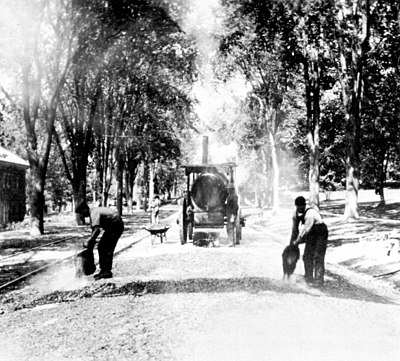
In 1909 the science of producing Portland cement concrete was in its infancy. This early rotary mixer was used at Cornell University in Ithaca, New York.
The Office of Public Roads’ dust prevention and experimental roads programs were the training grounds for the small group of highway engineers and physical scientists who later laid the foundations of soil engineering and pavement design.
Dragging the Dirt Roads
Dirt roads will not stand up under traffic unless they are shaped and kept free of ruts so that water will shed quickly and not soak in and soften the roadbed. Even before the Civil War, some township supervisors were smoothing their roads by dragging them with “a stick of timber, shod with iron, and attached to its tongue or neap obliquely, so that it is drawn over the road ‘quartering,’ and throws all obstructions to one side.”[1]

Applying bitumen on a stretch of road at Cornell University in 1910.
About 1905, D. Ward King, of Maitland, Missouri, improved on this simple device by splitting the timber lengthwise and positioning the two halves, one ahead of the other, to make a rigid platform. A typical King drag was made from an 8-inch log split down the middle; the two halves were held about 3 feet
- ↑ W. Gillespie, A Manual of the Principles and Practice of Road-Making (A. S. Barnes, New York, 1871) p. 191.
